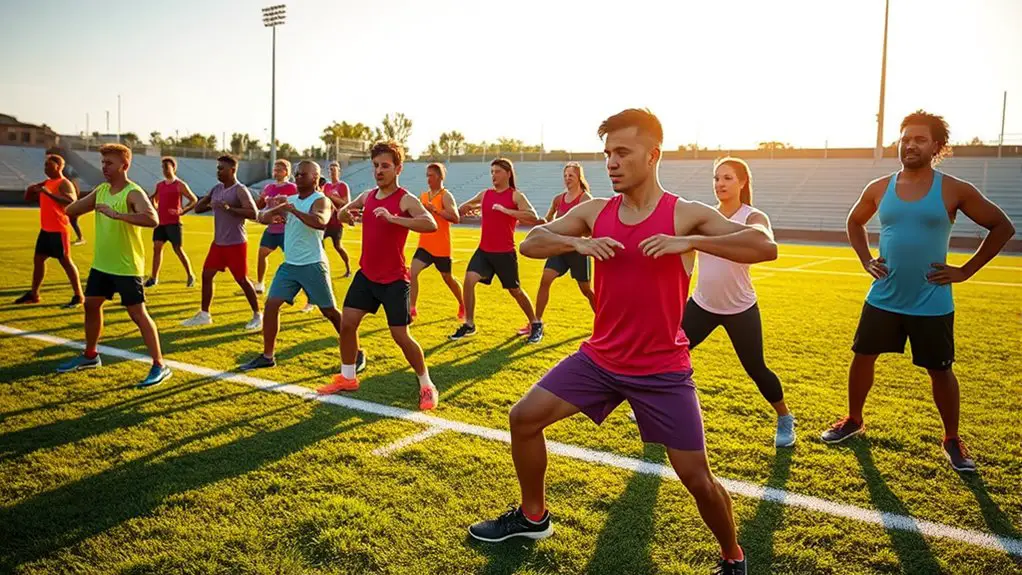To prevent hamstring injuries in sports, you should understand the anatomy and function of your hamstrings. Always start with a proper warm-up to increase blood flow and flexibility. Incorporating strength training like squats and leg curls helps build resilience. Don't forget to include flexibility exercises such as standing stretches and dynamic leg swings. Pay attention to signs of fatigue and allow for recovery. There's much more to learn on enhancing your hamstring health.
Understanding Hamstring Anatomy and Function
The hamstring muscles play an essential role in your body's movement and stability, particularly during sports. These muscles, located at the back of your thigh, consist of three main components: the biceps femoris, semitendinosus, and semimembranosus. They work together to facilitate bending your knee and extending your hip, vital for sprinting, jumping, and quick directional changes. When you engage in activities that require explosive movements, your hamstrings help maintain balance and support your lower body. Understanding how these muscles function empowers you to take charge of your athletic performance. By knowing their anatomy, you can appreciate their importance in preventing injuries and enhancing your overall freedom to move and compete without fear.
Importance of Proper Warm-Up Techniques
While you might be enthusiastic to jump straight into your sport, taking the time to warm up properly is essential for injury prevention, especially for your hamstrings. A good warm-up increases blood flow, enhances flexibility, and prepares your muscles for action. When you skip this step, you risk strains and tears that could sideline you.
Here's a simple warm-up routine you can follow:
| Exercise | Duration | Purpose |
|---|---|---|
| Light Jog | 5 minutes | Increases heart rate |
| Dynamic Stretches | 5 minutes | Improves flexibility |
| Leg Swings | 2 minutes | Activates hamstrings |
| High Knees | 2 minutes | Engages core and legs |
| Butt Kicks | 2 minutes | Warms up hamstrings |
Embrace your freedom in sports, but don't forget to warm up!
Incorporating Strength Training for Hamstring Resilience
To build resilience in your hamstrings and reduce the risk of injuries, incorporating strength training into your routine is essential. Strengthening these muscles not only improves performance but also enhances your overall freedom in movement. Here are some effective strategies to contemplate:
Incorporating strength training for your hamstrings is vital for injury prevention and enhanced movement performance.
- Focus on compound exercises: Squats and deadlifts engage your hamstrings alongside other muscle groups, building strength efficiently.
- Include hamstring-specific movements: Exercises like Nordic curls and leg curls target the hamstrings directly, promoting resilience and stability.
- Use progressive overload: Gradually increase weights or resistance to continually challenge your muscles, ensuring they adapt and grow stronger.
Flexibility Exercises to Enhance Hamstring Mobility
Building strength in your hamstrings is just one part of injury prevention; enhancing flexibility is equally important. Incorporating flexibility exercises can free your body, allowing for greater movement and reduced risk of injury. Here are some effective hamstring stretches to evaluate:
| Exercise | Duration | Repetitions |
|---|---|---|
| Standing Hamstring Stretch | 30 seconds | 2 per leg |
| Seated Forward Bend | 30 seconds | 2 |
| Lying Hamstring Stretch | 30 seconds | 2 per leg |
| Dynamic Leg Swings | 10 swings | 2 per leg |
| Pigeon Pose | 30 seconds | 2 per side |
Incorporate these stretches into your routine, and you'll enhance your hamstring mobility, keeping you agile and injury-free on the field.
Listening to Your Body: Recognizing Signs of Fatigue
As you push your limits in training or competition, it's crucial to listen to your body and recognize the signs of fatigue. Ignoring these signals can lead to injuries, particularly in your hamstrings. Stay aware of how you feel to maintain your freedom in movement and performance.
- Persistent soreness: If you're feeling discomfort that doesn't fade after a warm-up, it's time to take a break.
- Decreased performance: Notice if you're struggling to keep up with your usual pace or intensity; this could indicate fatigue.
- Muscle tightness: If your hamstrings feel unusually tight or stiff, it's a warning sign that you may need to ease off.
Trusting your instincts can help you avoid serious setbacks and keep you in the game longer.
Best Practices for Recovery and Rehabilitation
While pushing through training is essential, prioritizing recovery and rehabilitation is equally important to prevent hamstring injuries. Start by incorporating rest days into your routine; your body needs time to heal and adapt. Stretching is key—focus on gentle, targeted stretches that enhance flexibility without straining your muscles. Consider cross-training with low-impact activities like swimming or cycling to maintain fitness while reducing stress on your hamstrings. If you've sustained an injury, follow the RICE method: Rest, Ice, Compression, and Elevation. Gradually reintroduce strength training and guarantee you're balancing workouts with adequate recovery. Listen to your body; don't rush back into high-intensity activities. Embrace these practices, and you'll find freedom in your movement, avoiding future setbacks.
Frequently Asked Questions
What Are Common Risk Factors for Hamstring Injuries in Athletes?
Common risk factors for hamstring injuries include muscle imbalances, inadequate flexibility, prior injuries, and fatigue. You'll also find that sprinting, abrupt changes in direction, and poor warm-up routines can increase your chances of injury.
How Do Different Sports Impact Hamstring Injury Risk?
Did you know that sprinters face a 70% higher risk of hamstring injuries compared to distance runners? In different sports, the intensity and movement patterns can greatly increase your chances of injury, so stay aware!
Can Nutrition Play a Role in Hamstring Injury Prevention?
Sure, nutrition's essential for overall muscle health. When you're fueling your body right, you're more likely to maintain strength and flexibility, reducing the risk of injuries. So, don't underestimate the power of a balanced diet!
What Equipment Can Help Reduce Hamstring Injury Risk?
Did you know that 30% of athletes experience hamstring injuries? To reduce that risk, you might consider using resistance bands for strength training, foam rollers for recovery, and proper footwear for ideal support during activities.
Are There Any Specific Age-Related Considerations for Hamstring Injuries?
As you age, your muscles lose elasticity and strength, increasing injury risks. Staying active, incorporating flexibility training, and listening to your body's signals can help you maintain performance and reduce the likelihood of hamstring injuries.




